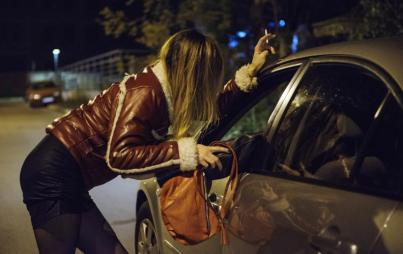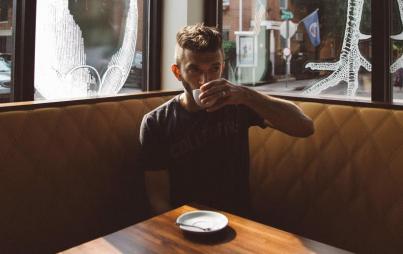
A look at how human trafficking victims fare in life and love after surviving the sex trade.
Samantha* is 30 years old. She's a makeup artist, a nanny, a professing Christian and an advocate against human trafficking. This cause is near and dear to her heart because she's been there herself.
At the age of 24, she wandered into what she thought was a job interview in Southern California, and ended up being drugged, beaten, raped, and forced to work in the commercial sex industry.
As horrifying as this sounds, her story isn't an isolated incident. Human trafficking is a $32 billion industry worldwide, and the United Nations has found evidence of it in 80 percent of the countries around the world.
The Not For Sale Campaign, a nonprofit dedicated to ending modern-day slavery, estimates that between 14,500 and 17,500 people are trafficked in the United States each year, with 30 million enslaved around the world. The U.S. Department of State reports that 80 percent of all trafficking victims are women and children that have been forced into the commercial sex trade, just as Samantha was.
Yet, Samantha is a survivor and doesn't want that part of her life to define her anymore. It happened almost ten years ago, and now she's free. Just like other women her age, she's searching for the right career as well as the right partner to one day spend her life with.
When I think about Samantha dating after all that she's been through, it strikes me how difficult it must be for her to open up and learn to trust again. She's willing to try, and her healing process has already been an incredible journey.
It all began with one man who wandered into the club where she was stripping. It was this man's love and support, in combination with the counseling she received at a nonprofit organization called Treasures, that gave her the courage and strength to change the course of her life.
But before I go any further, I should tell you her story. It's heartbreaking and beautiful all at the same time.
Samantha moved to Los Angeles when she was 24. Her dream was to have a successful modeling career, and she began pursuing her goal by attending casting calls that were advertised in the area. In the midst of her job hunt, she was contacted by a "modeling agency" that was interested in representing her.
Once she arrived at the photo shoot, they gave her some drinks, asked her to take a few topless shots, and then asked for her identification so that they could make copies for her file. Everything after that, she says, is a blur.
These men drugged her drink, and then proceeded to beat and sexually assault her. Over the next few months, they forced her to work in the porn industry, and withheld all of her identification unless she did exactly what they said. They also threatened to send the topless photos they had taken to her family and friends if she wasn't cooperative.
It all came to an end one day while driving through the streets of Hollywood with her captors.
"I started throwing one of my usual temper tantrums," she said. "I can be very strong-willed, and very obnoxious when I want to be. And that day, my captors finally reached their limit and decided I wasn't worth dealing with anymore."
Samantha said they got angry, dropped her off in front of a strip club, and told her to fend for herself. She never saw them again after that, but she also had no money and nowhere to go. She went inside the club, asked if she could dance, and thus began the next phase of her life.
"I hated every minute of it," she said. "I kept telling myself I was going to stop stripping, but in reality, I didn't know how."
Her journey out of the sex industry and into the life she now leads today began, perhaps surprisingly, with two inanimate objects: The first was a cross necklace, and the second was a magazine.
Samantha was raised as a Jehovah’s Witness and often wore a dangling cross hanging around her neck while she stripped. She saw it as a form of protection and comfort.
One night, a group of men came into the club for a bachelor party, and one of them noticed her necklace. He asked her why she was wearing it, and after listening to her answer, he wrote his phone number down on a piece of paper.
"You don't belong in a strip club," he told her. "If you ever want to stop doing this, just call me. I'll come pick you up, I'll help you with whatever you need. But just remember that you're worth more than this."
For weeks and months after that, he would drop by the club periodically to check on her and make sure that she was doing all right. At first, Samantha wasn't sure if she could trust him, but eventually she decided it was worth a try. She sent him a text asking him to come pick her up, and to not let her go back to the club, no matter what.
"Whenever I felt desperate and was tempted to go back, I would call him and he would talk me out of it," she says. "He was a source of constant support." He also encouraged her to explore her faith by reading The Bible and finding a church she wanted to attend.
During this time, Samantha got a magazine in the mail that featured a story about Treasures, a faith-based nonprofit that helps women find healing after being trafficked or working in the sex industry. It's located in the San Fernando Valley where 95 percent of all legal porn is filmed and distributed. The founder of the organization, Harmony Dust, was once a stripper, and is able to understand the emotions and struggles of the women she counsels.
After reading the article, Samantha got on the phone and called Dust. She has since gone through extensive counseling with Treasures and says that speaking with Dust allowed her to take the first important step: recognizing that what happened to her wasn't her fault.
"I felt so much guilt and shame because I thought that I was stupid for going to the photo shoot without taking anyone with me. I thought, 'If only I didn’t have that drink, if only I hadn't taken those pictures,' then none of this would have happened."
Mary Jo Rapini, a licensed psychotherapist, says that this is a common response she sees in the trafficking victims she counsels.
"Many feel that because they went along with it, they are just as guilty for what happened to them. In order to break that thought pattern, we talk them through the experience and enable them to see that they are survivors; they didn't just go along with it. Being a part of something because you fear the loss of your life is much different than making an active choice."
Throughout the rehabilitation process, Samantha started dating the man who took her out of the strip club. It was her first serious relationship after being trafficked, and she found that learning to trust was a major obstacle for her.
"I had to move past my fears that he was the type of guy who always picked up on dancers," she said. "I had to be sure that he really saw through me and cared about who I was inside, not just what I could give him sexually."
As for Samantha’s boyfriend, he too had fears about their relationship that needed to be worked through.
"He was afraid that I would start stripping again," she said, "and he became a bit possessive and overprotective of me, especially if we were out together in public and someone recognized me from the club."
There was one time in particular where a guy approached Samantha’s boyfriend and asked, "Do you know who this girl is? Do you know who you're out on a date with?"
"That's none of your business," he responded. "And she's not that person anymore."
Although they're no longer romantically involved, they're still in regular contact with each other and remain friends. Samantha has since dated other men, and says it took her a while to start attracting the right type of guy.
"At first, I was getting hit on by guys who were making sexual comments, trying to get me drunk, and pushing me to go farther than I wanted to physically. It took me a while to figure out what the red flags were and to run when I saw them."
According to Stephanie Pollaro, this is a typical problem amongst women and girls who have been trafficked. Pollaro is the founder of International Sanctuary, a nonprofit based out of Mumbai, India and Irvine, California.
"Isanctuary" works primarily with teenagers who have been forced or sold into sexual slavery. They're most known for the fashionable jewelry that they sell online and in small boutiques throughout the United States, each piece assembled by a trafficking survivor who is then able to support herself through the profits.
"[Human trafficking survivors] don't really understand the concept of boundaries and what a healthy relationship is supposed to look like," she says. "They think it's normal when boys show them pornography, and I have to explain to them that it isn't. They don't know how to set higher standards for themselves, or to recognize that they are capable of being a different person than they were before. They need to be taught all of those things, and it's a slow learning process."
Throughout her years of working with these girls, Pollaro admits that the final outcomes tend to vary. Some run away and end up getting re-trafficked, or voluntarily going back to work in the sex industry. Others run away and she has no idea what becomes of them.
Yet, she's also seen several girls grow up, go to college, start careers, get married and have children.
"A woman we worked with years ago came in just the other day with her baby and herhusband," she says. "It was wonderful to see her doing so well."
Learning to set boundaries and maintain higher standards is still only the beginning of a long road toward recovery. Rapini urges any couple with this type of history to seek counseling together, as many women who have been trafficked suffer from Post-Traumatic Stress Syndrome.
She also discusses the complications that occur in regards to sexual intimacy within their relationship.
"Sex is a connection between two people," she says. "For women who have been trafficked or worked in the industry, that whole concept has been changed for them. Sex is turned into something they do to serve somebody — and often in a violent manner."
I spoke with Jillian Lauren, author of Some Girls: My Life in a Harem. Her memoir is about being a personal escort in New York City, and eventually working in a harem for the Prince of Brunei. Lauren isn't a trafficking victim, as all of her time in the sex industry was purely consensual. However, many of the obstacles she faced in recovering from that portion of her life are quite relevant.
Lauren was physically abused as a child and says that whenever it happened, she would allow her mind to drift off so that she could mentally escape from her body as a coping mechanism.
When she started working as a personal escort, she would employ the same technique, and refers to it in her memoir as "severing the connection between the body and the soul." She admits that it's a damaging experience, and that it's taken a lot of therapy for her to learn to reverse it.
"My body is the source of my original injury," she says, "so the counseling and therapy I've done usually starts with that. I've tried acupuncture and deep-tissue muscle release. The primary emphasis is always on learning to love and honor my body."
Both Lauren and Samantha agree that their experiences have not negatively impacted their views of men.
"I wasn't trafficked," Lauren says, "I worked in the sex industry willingly, and eventually needed to tell whoever I was dating about my past. Some men saw it as an excuse to objectify me and their entire attitude toward me changed. Other guys just got really scared."
Samantha agrees, and knows from her own experience that there are understanding men who can look past everything else and see into her heart.
"I know it's not this way for everyone who's been trafficked," Samantha says, "especially when it comes to sexual intimacy with a guy. I've been beaten and raped, and for some women, it's very hard to move past that.
For me, however, I believe there are good men and there are bad men. It's very black and white. I wouldn't want to ruin my relationship with a good man by blaming him for things that bad men have done to me. At this point, I'm able to separate the two."
This article originally appeared at Your Tango. Also from Your Tango:
My Ex Threatened Me With Revenge Porn — Here's How I Stopped Him
17 Dumbest, Most Disturbing Aspects Of '50 Shades Of Grey'
10 Inspirational Quotes About Change To Get You Out Of Your Slump








